The first trial gets pretty scary when a belt slips! More details on this ambitious Pixhawk-powered gas quadcopter below:
My primary goal when I started this project was to create a large scale quadcopters. An electric powered design would have been the most straightforward approach. Electric motors are more efficient than gas, but the power density of gasoline is much greater than today's batteries. So until battery technology improves, gas power seemed the way to go. Goliath uses a single 30HP engine and a belt system to transfer power to the four propellers. The setup was chosen because at this scale, four smaller engines have a smaller power to weight ratio than a single larger engine.
An electric quadcopter would traditionally maneuver by varying the speed of each propeller to control thrust. Since Goliath uses fixed pitch propellers and all the propellers turn at the same speed due to the belt drive, maneuvering will be done by control vanes similar to those used to steer hovercraft.
Flight control will be performed using the Pixhawk controller running a modified version of the Ardupilot flight software. Modifications to the Ardupilot software are needed to work with Goliath's unique control system. Both the Pixhawk and Ardupilot are open source. The modifications made will be open source as well. A USB radio receiver will be attached to the flight controller and setup to receive ADS-B signals. These signals will allow the operator to be aware of other aircraft operating in the area.
Additionally Goliath will have a WiFi interface allowing the public to interact and connect with Goliath. Data and Video Feeds will be available and observers can notify the operator of potential issues.
Goliath itself will be open source with the creative commons license, and whenever possible open source components were used. It's currently a work in progress, and even when completed it's intended as a starting point for future vehicles.
COMPONENTS
- 1×30 HP vertical shaft gas engineShould equipped with a starter and alternator
- 4×Center Beams ( 2 1/2" x 1 1/2" x 39 3/4")Galvanized Slotted Angle
- 4×Side Beams ( 2 1/2" x 1 1/2" x 29 1/4" )Galvanized Slotted Angle
- 4×Cross Beams ( 2 1/2" x 1 1/2" x 30" )Galvanized Slotted Angle
- 4×End Beams ( 2 1/2" x 1 1/2" x 18" )Galvanized Slotted Angle
- 8×Outer Prop Supports ( 1 1/2" x 1 1/2" x 30 3/4" )Galvanized Slotted Angle
- 4×Inner Prop Supports - Fore ( 1 1/2" x 1 1/2" x 28 1/4" )Galvanized Slotted Angle
- 4×Inner Prop Supports - Aft ( 1 1/2" x 1 1/2" x 32 1/4" )Galvanized Slotted Angle
- 8×Shaft Mounts - ( 2 1/2" x 1 1/2" x 6")Galvanized Slotted Angle
- 4×End Cross Bars ( 1 1/2" x 1/16" x 18" )Galvanized Slotted Bar
PROJECT LOGS
Picking up the Pieces
2 days ago • 0 commentsIf you hadn't seen the previous post yet, the gas engine was started for the first time, but during the process the vehicle was damaged.
Afterwards, I took an assessment of the damage to Goliath and tried to figure out where things went wrong.
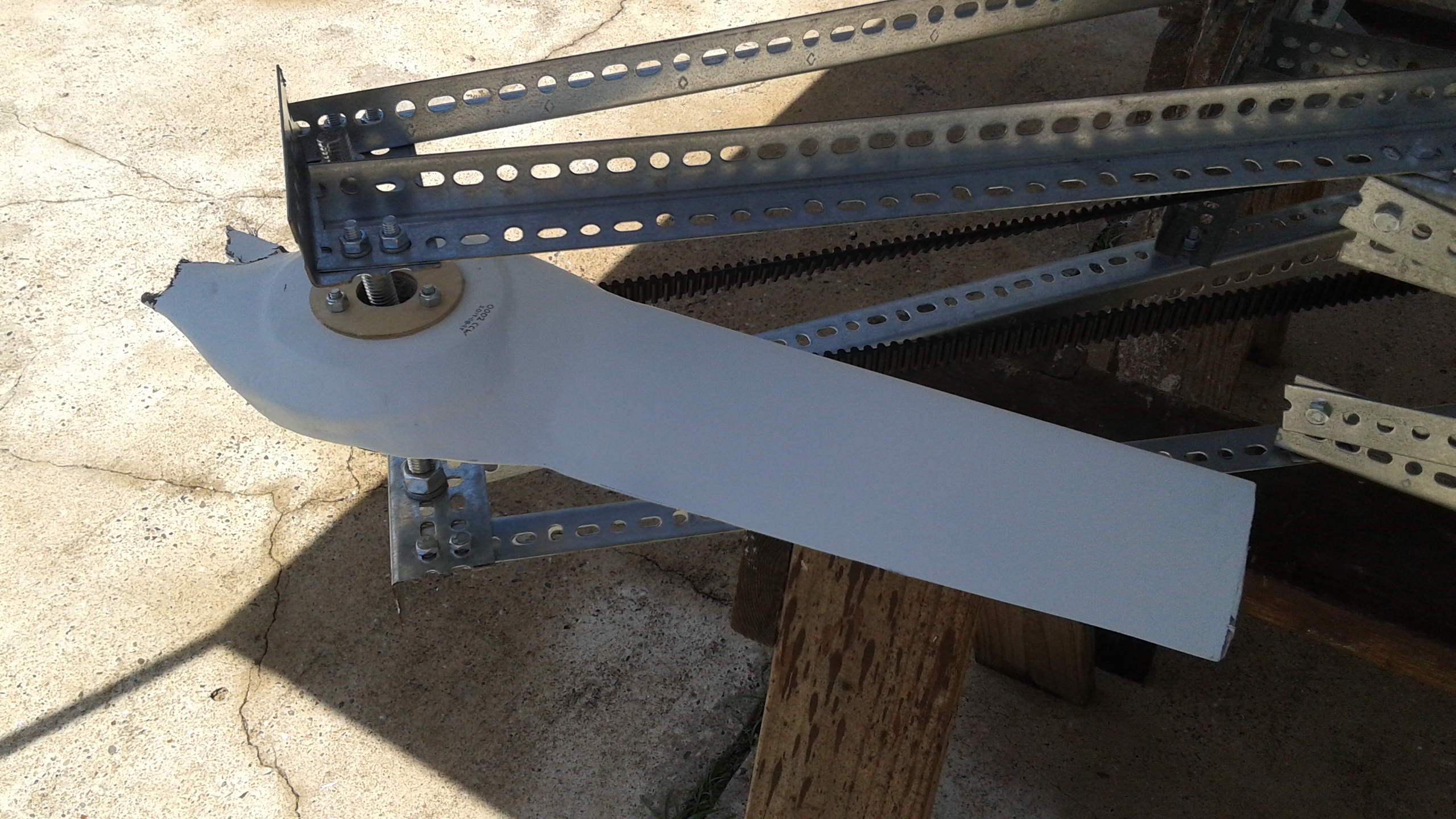
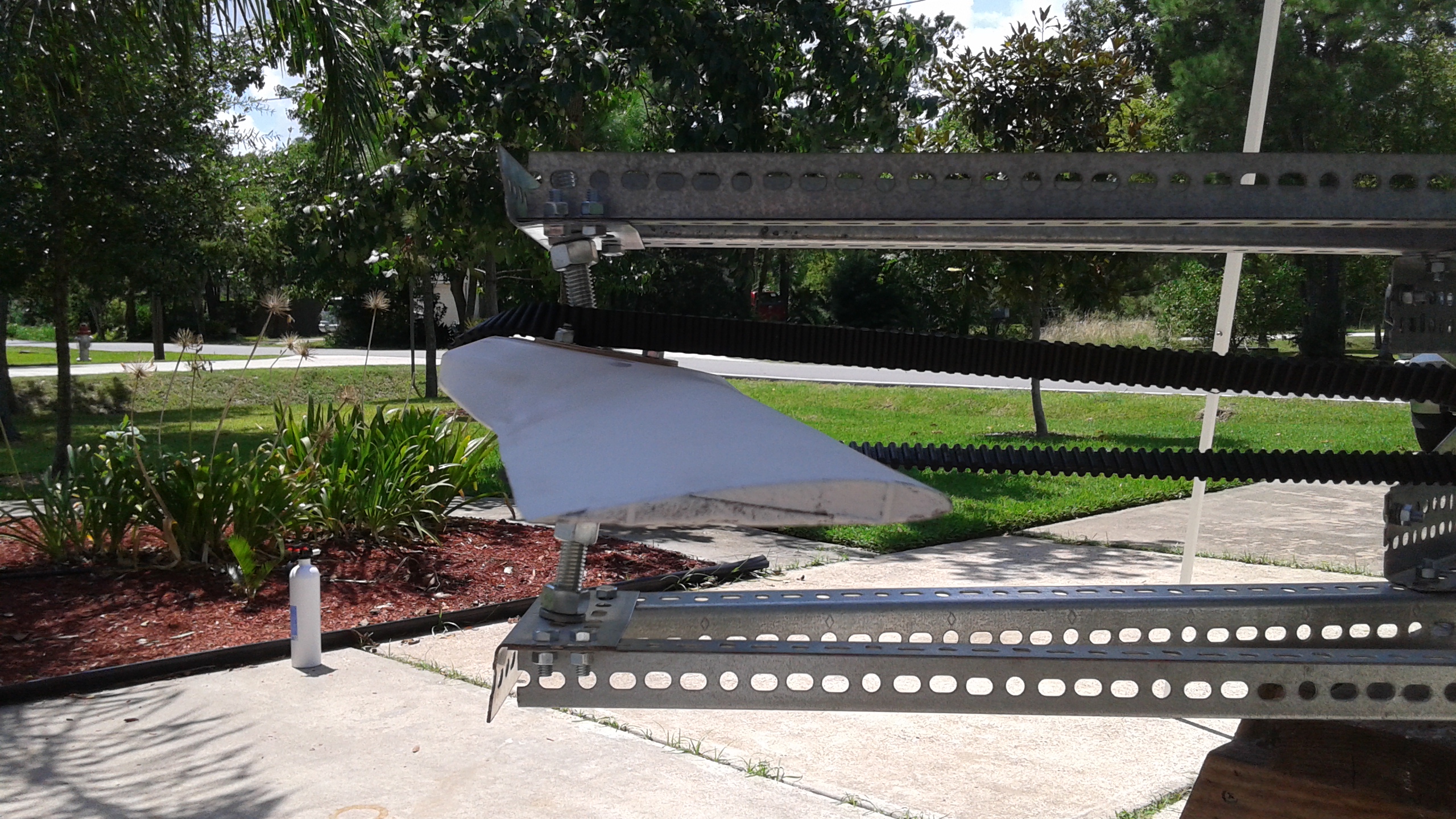
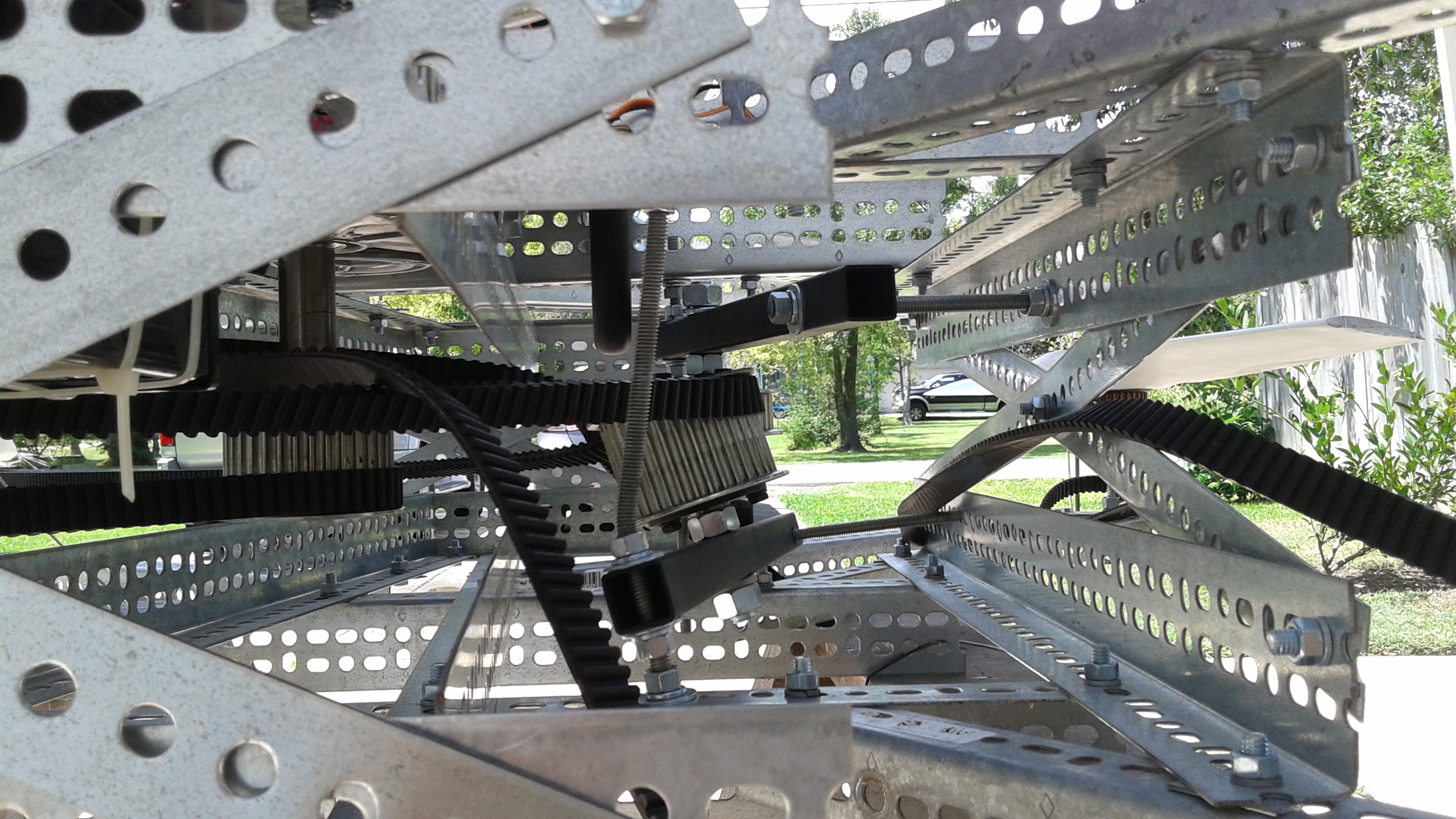
After watching the video a few times and looking at the damage to the vehicle, I think I have a good idea of what went wrong and what I can do to prevent it from happening. Things were running good until the engine was shutoff. At this point one of the belt started losing tension. You can see this in the video at the lower right hand belt starts to flap. This was likely do the the engine spinning down faster than the belt. At some point the belt gets so much slack, that the belt bounced up and the propeller went under it and the belt got wrapped around the prop. Once it was tangled the belt cinched up really tight and bent two of the propeller shafts and the belt tensioner support. The other propeller attached to the belt was sheared off when it's axle was bent and the propeller hit the angle iron support.
The changes I need to make to the vehicle to keep this from occurring again are:
- Add a one-way (overrunning) clutch to the engine pulley
- Add belt guards to prevent the belt from flying up into the path of the propellers
I may also need to add some auto tensioners, I need to do a bit more research into it.
Otherwise the test went well. We could really feel the wind coming off the vehicle. I'm really amazed that the belts are as strong as they are. I would have thought that the belt would have snapped in this situation. I've already started on making two new propellers and hopefully the process will go faster now that I've done it a few times.
Hover Testing...Broken Vehicle
5 days ago • 2 commentsUPDATE - Great news, got the engine started! Bad news, I broke lots of stuff! See bottom for details
I'm taking advantage of a four day weekend by doing a series of tests, eventually building up to a hover test. I'll be updating this post over the weekend as I make progress towards the hover test. I plan on sharing whatever happens good or bad, and since these things seem to never go according to plan, please be patient if it seems like it's taking too long or nothing happens at all.
As I laid out in the last post, Today (Friday) the plan is:
- Friday - Attach the rotors and test everything out using only the starter
- Saturday - Run the engine on gas for the first time, but only at low speed
- Sunday - Run the engine at higher speeds, building up to a hover test
- Monday - Not cleaning up debris from a failed test
FRIDAY AM
So the weather this weekend does not look good. Today (Friday) is an 80% chance of rain, Saturday 90 %, Sunday 80% and Monday is 40%. Things might slip a bit. I was running out of room in the workshop to actually work on the vehicle with the rotors attached so I moved it outside under a pop-up canopy to get the last two rotors attached. I have them attached, but I'm still adjusting all of the pulleys to make sure they are all aligned. It started raining so I lowered the shade to cover Goliath better and waiting for a break in the rain. I did get one other important item installed (below).
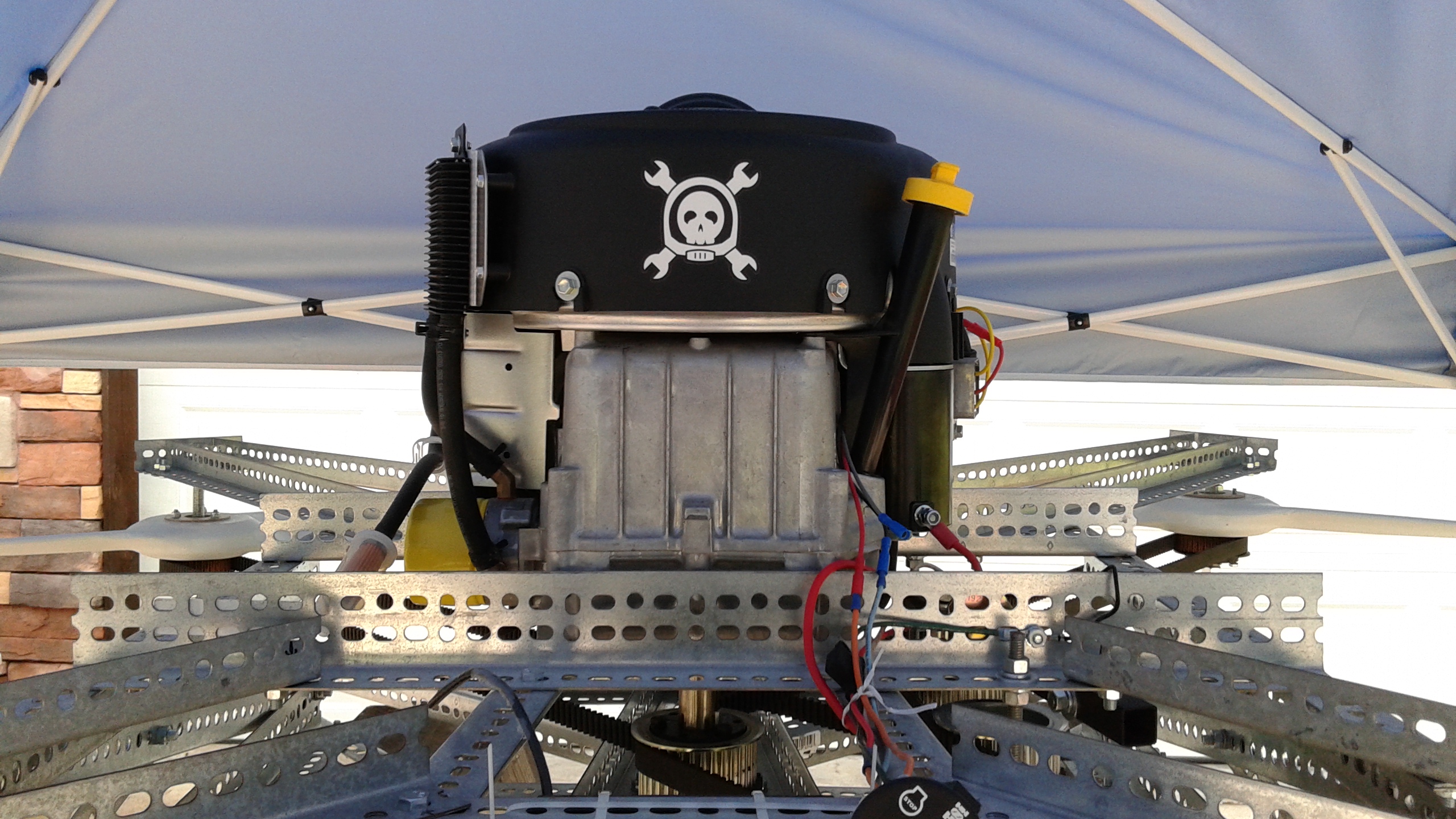
I got my T-Shirt this week from the "Astronaut Or Not" Challenge, specifically the "Most Outrageous Component" round. They also sent included a few stickers, one of which is now placed on the engine.
FRIDAY AFTERNOON
So the rain let up for a while and I was able to finish adjusting the pulleys and belts. Goliath is finally starting to look like a quadcopter.
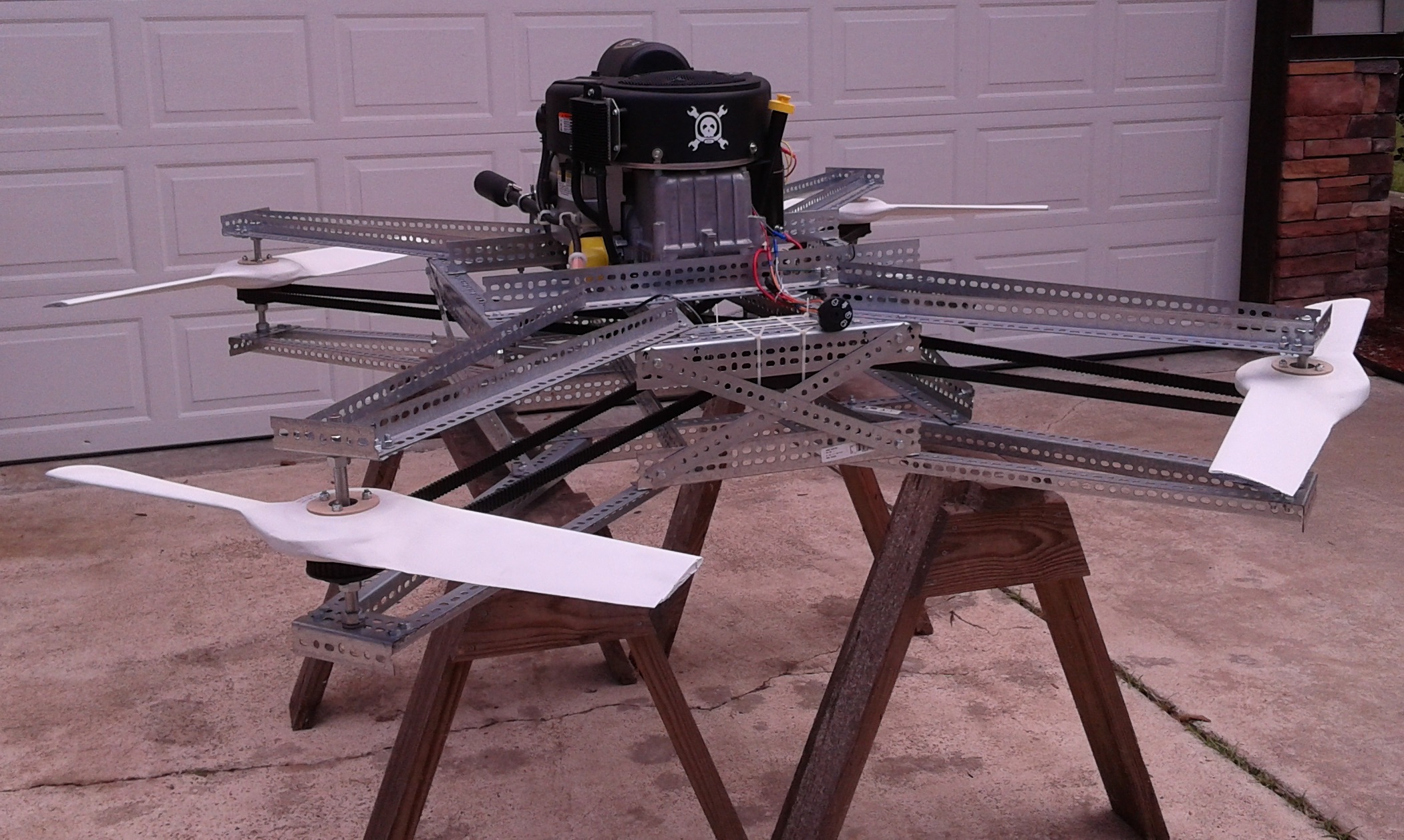
Next step is getting ready to remotely start the engine. Previously I had connected an riding lawn mower ignition switch to Goliath for testing out the starter and other hardware. Later the ignition will be controlled with the Pixhawk controller, but for doing some preliminary testing. I need to start the vehicle remotely for safety reasons, so I rigged up an extension for the ignition.
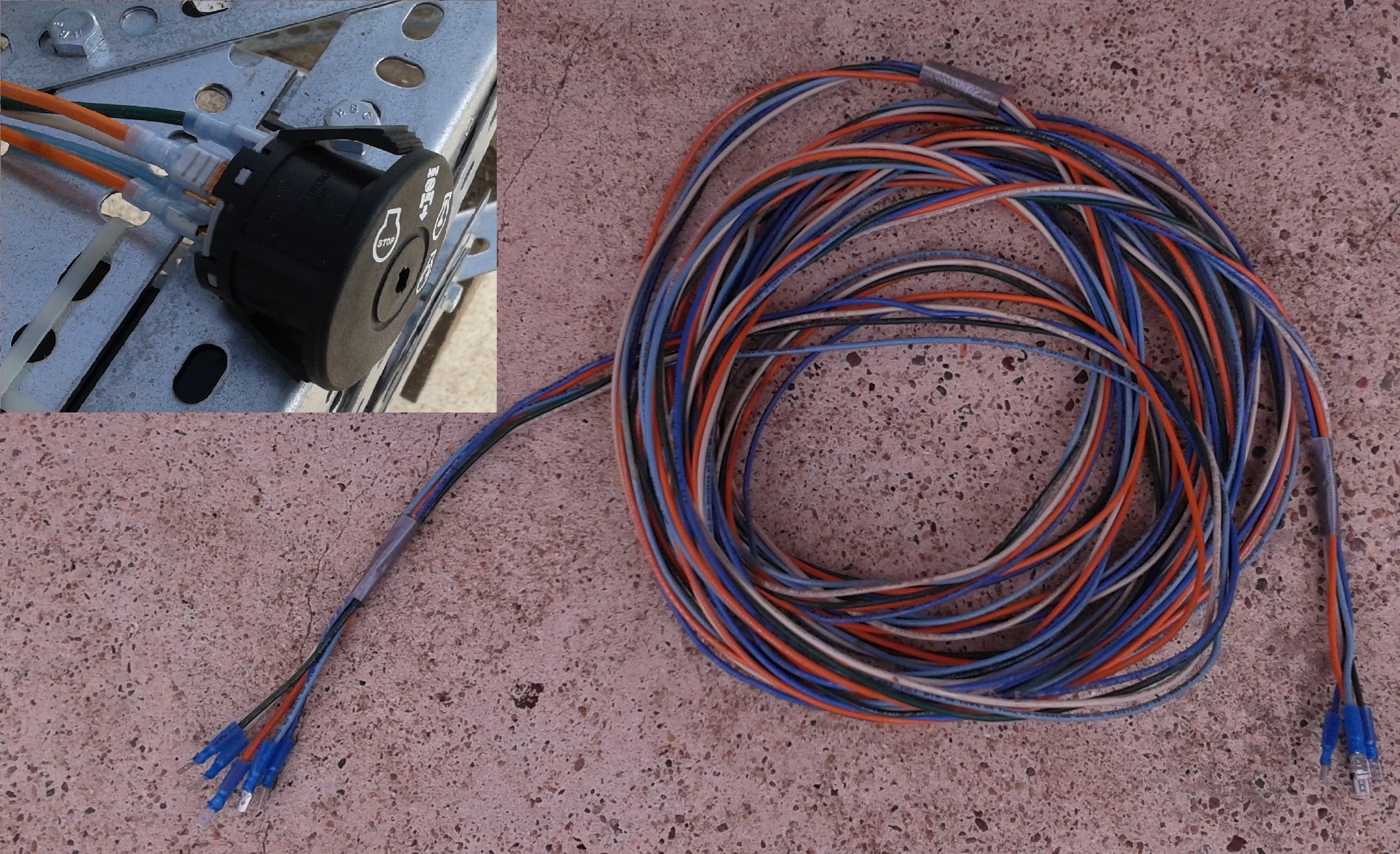
Last step is making sure Goliath isn't going to go anywhere while just running the starter. I'll get more serious with ties down for the hover test.
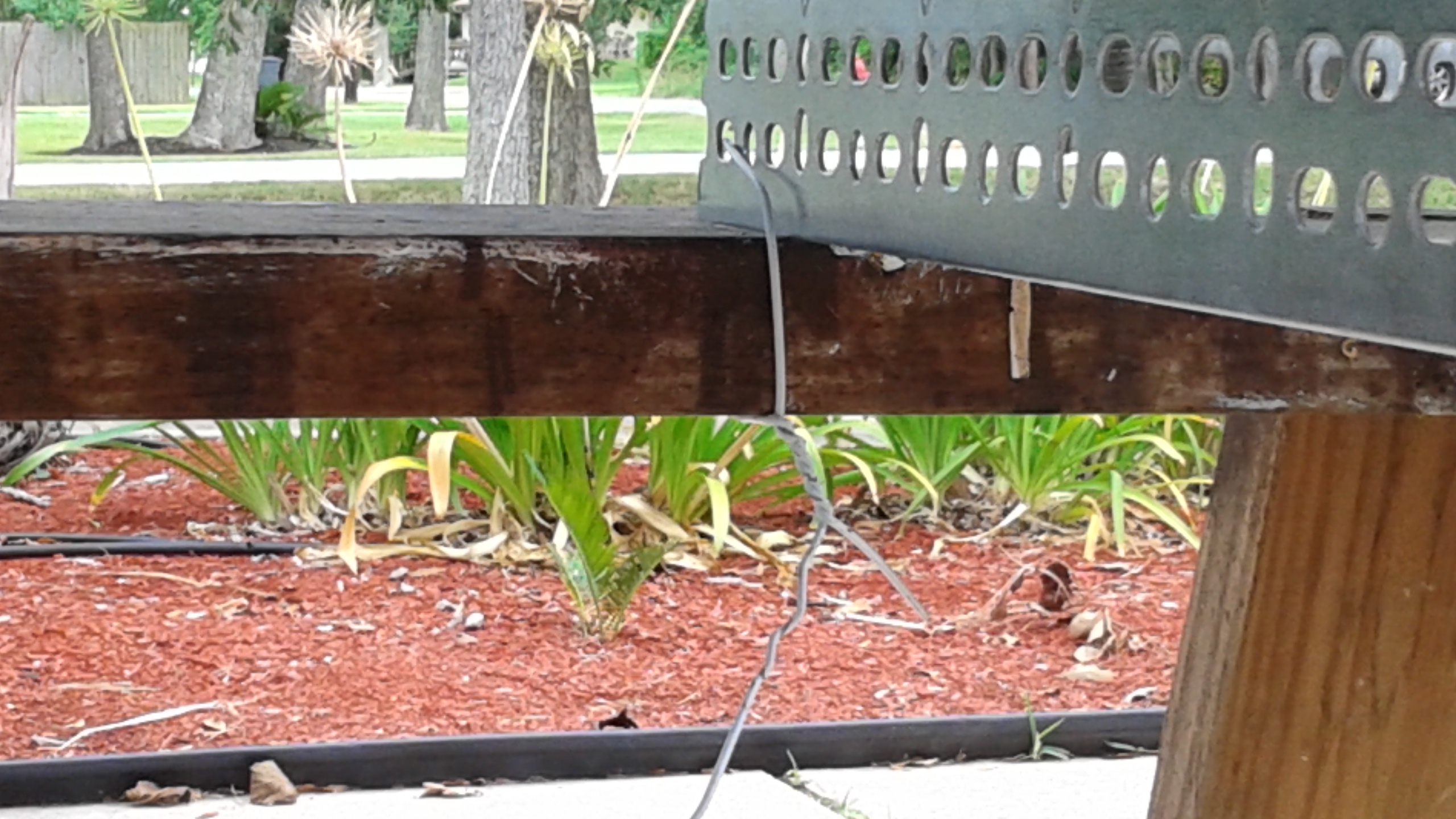
With all those things done, it was time to try it out.
Everything seemed to work as expected, so everything looks good for running the engine on gas next.
SATURDAY PM
So after meeting all the goals on Friday, Saturday did not go as well. The first part of the day was doing a bit more research into the Pixhawk controller. I'd like to have the Pixhawk included as part of the hover test and I'm working on making sure I have everything I need. Turns out I misunderstood some of the documentation on the Pixhawk. While the Pixhawk has 8 main and 6 aux PWM outputs, the Pixhawk does NOT provide power for servos.
To power servos off the Pixhawk, a BEC needs to be connected to one of the servo inputs to provide power to the rest. So this morning I called around and got a Castle 10AMP BEC that will convert the voltage from the 12 V Battery currently on Goliath to what the servos need. This will be in addition to the Voltage Converter that powers the rest of the Pixhawk.
After making a trip to the Hobby Shop, I got ready for today's testing. First thing was getting the fuel solenoid tied in to the ignition switch. After that I connected a temporary gas setup consisting of nothing more than a 1 gallon gas can with 1/4" tubing shoved in it and taped off.
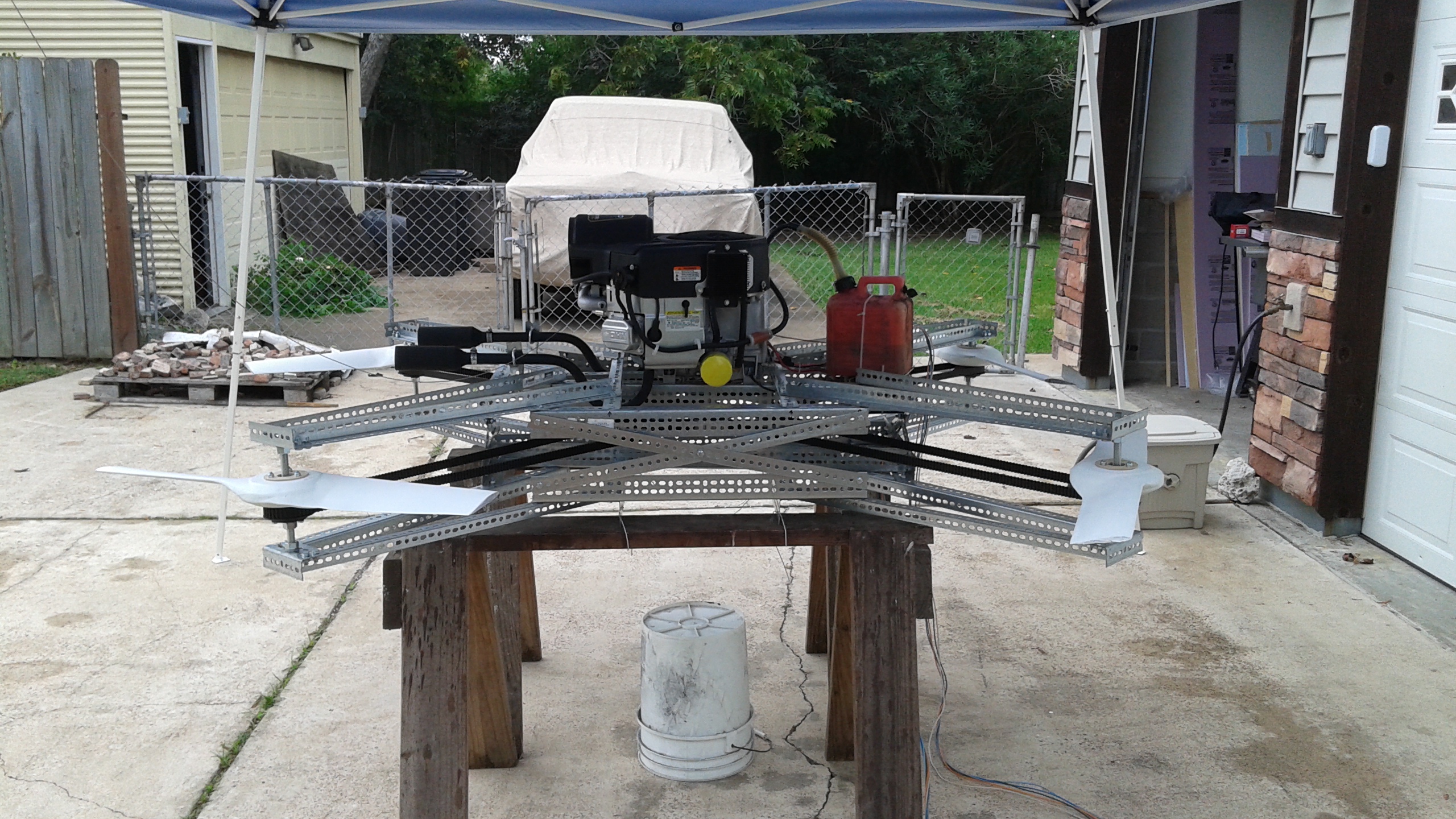
I had wanted to keep the gas separate from the rest of the vehicle, and it was setup underneath at first, knowing that the change in height might be too much for the fuel pump. However after turning the engine over several times it was obvious the fuel wasn't reaching the engine. The...
Read more »
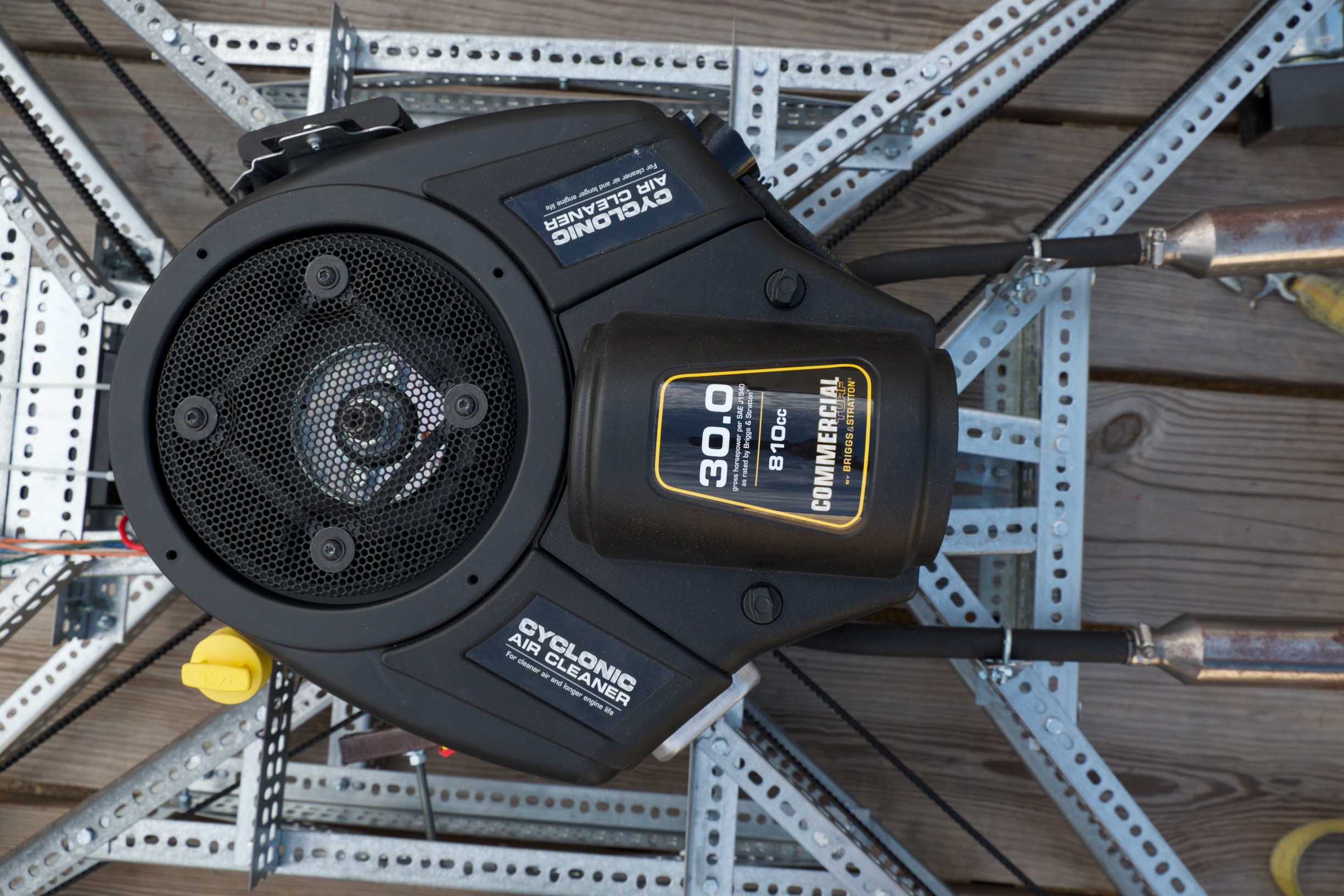
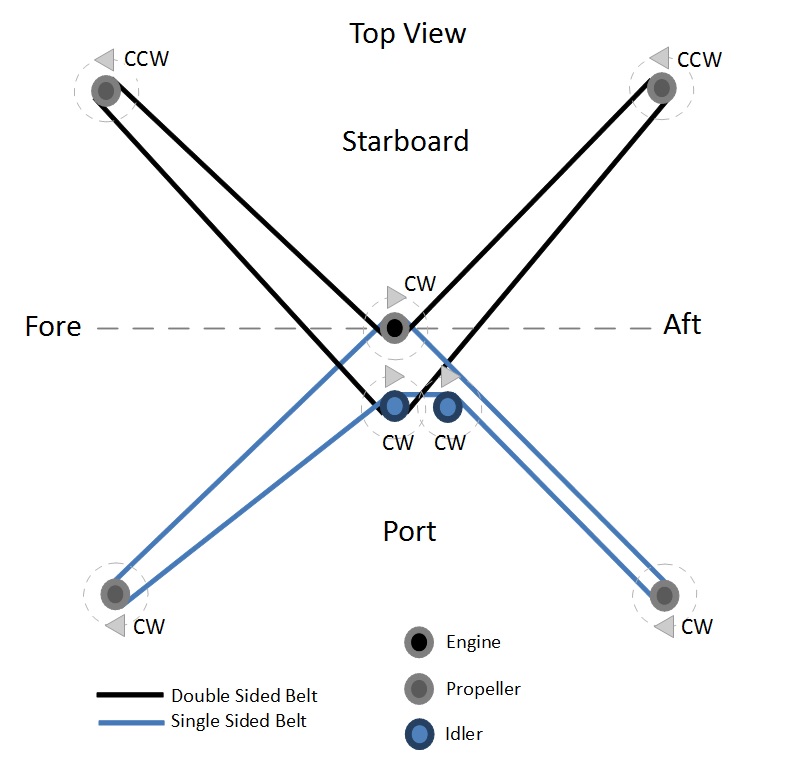
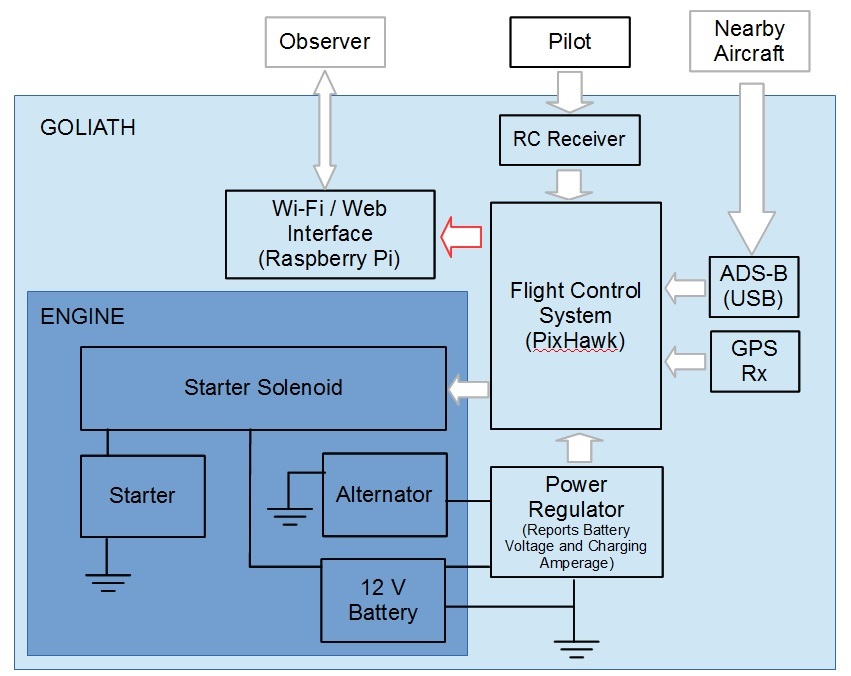
Comments
3 letters describe my reaction to seeing this thread after a week away from the forum: W. O. W. Huge Props. How did you make those props/where did they come from?
I don't even know what to say, the first word that comes to my mind is (RUN). Structural faults galore, wrong building materials just to start with. Take my advice and Save a life, put the engine back on the lawn mower and hang the garage door opener back up. I'm not trying to be funny.
I remember 40 years ago one of the neighbor kids that I grew up with built a hover craft. Looking back I think it's the reason I had taken a few engineering classes years ago.
He worked all summer long on this thing and a few days before he test flight it I told him DON'T.
Well he didn't listen and I didn't take part in his big day and glad I didn't. To make a long story short, the engine vibration ripped the wooden framing apart and when the engine mount broke loose and his legs fell through the upper structure of the craft the prop took one leg off.
Once he was at the hospital they tried to save his other leg but it was so torn up they had to take it off at the knee. It took month's for his stumps to heal and stop oozing blood and Pus and I remember him telling me that he was sorry for not listening. About 2 years later he died of infection , blood poisoning from his stump rubbing in his prosthetic leg.
His 10 seconds of fame cost him his life.
So think twice.
Rob, I totally agree and often seeing attempts like this remind me that inspiration needs to be tempered with research.
Helicopters have never been mechanically simpler with DFC/Flybarless setups. The electronics can work well with good mechanicals systems. Witness the huge surge in 3D heli builds and flyers.
I totally get the use of an ICE engine. No one would debate power density of fuel versus battery.
Speaking of research, even the web has useful information from say, 1960...
...seen any of these flying around lately? Me either. I am not certain but, it looks like the wing fans have shaft drives going to a gear box at the top. Note also the use of 'under structure' props/fans. These fellows made the decision to mount under their support structure.
The AH-56 Lockheed Cheyenne had a rear prop for forward thrust also. The AH-56 first flights were in 1967.
Funny that was seven years after this magazine was published.
Oh, I just pulled the trigger on buying this issue off eBay. If there is more than just a cover shot, I will share.
I grew up reading Air Progress and actually wanted to be an aviation journalist.
Budd Davisson was my hero.
-=Doug
This Thing Looks Like A Good Way To Die and 30hp WHY People have tooooooo much free time
Sean, yeah, the whole thing doesn't seem very well designed. I didn't want to be debbie downer but...
Doug, yes, that approach works. I just cannot get my mind to see what the point is. You've now created a machine that is more complicated, and less efficient than a helicopter.
Those shafts at the rotors seem a little narrow for 7.5hp + belt tension.
Can't edit my last comment here is the video CYB on fuel engine quadrotor https://www.youtube.com/watch?v=uuExXFCCDgA
Yeah...wow.
Reminds me of previous attempts like the SkyCar... sorta. Moller
So...if I were going to go with an ICE power source that size, the Youngblood approach works. Just scale it up and perhaps go with shaft drives.
Wow.
-=Doug
The only way I can figure to stabilize a multicopter with fixed pitch and fixed speed props is to use variable area nozzles.
-
1
-
2
of 2 Next